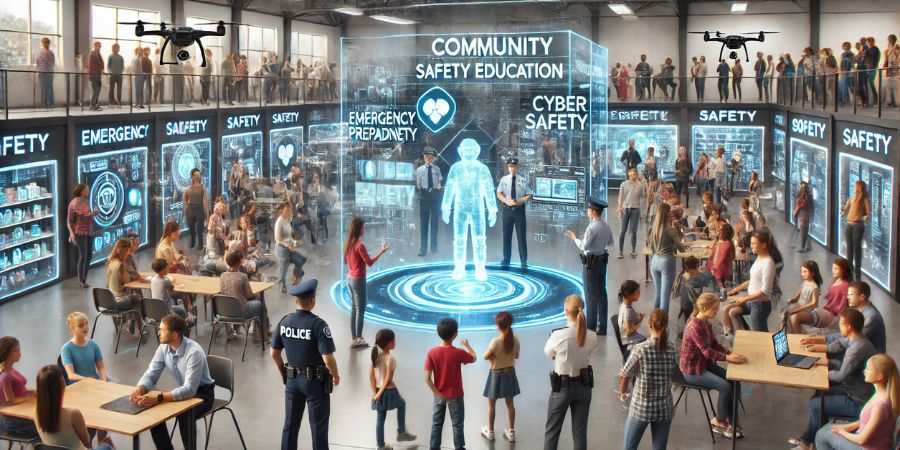The rules of years are changing with the new modern world, and one of the values today is more so costly community safety education. It sets the tone for educating people to self-identifying, preventing, and responding to threats, and what yields is proactive safety culture. It is this process that will explain why community safety education matters, what benefits accrue from it, and some means of achieving this.
Community Safety Education: The Why’s
This is just about the foundation upon which a society secures a vastly informed and safe vista for its citizens. These initiatives must not merely concerned disseminating information in terms of creating culture to develop proactive vigilance and collective responsibility. To law enforcement, programs like this would assist citizens of the community in identifying and reducing the risks and hazards that exist for use in crime control. For educators, these initiatives empower young people to imbibe the values of respect and compassion, which are vital to peaceful coexistence. For community leaders, such initiatives use it as a platform to engage residents to motivate them towards collective participation in safeguarding their environment. The multi-pronged benefits posed by education and awareness initiatives really deserve attention, and these must also be embraced for consideration as vital tools in any community strategy.
Benefits of Community Safety Education
Increased awareness: Safety education goes beyond making an individual aware of potential hazards or risks in the surroundings. Both student and community will thus be able to come across a recognition of danger or hazard and a prevention of accidents and injuries.
Reduction of Accidents and Injuries: Safety education reduces accidents and injuries. Safety practices are at home, on the road, or in public. They will encourage responsible behavior and decision-making.
Empowered Decisions: It is the safety education that enables persons to understand what is or is not, or when to carry out a decision in emergencies. Safety education helps people to develop their judgment in evaluating such risks and how to respond in an emergency situation.
Safety Culture Improvement: As safety education is more and more integrated into curricula and community programs, this can greatly increase uplifted safety culture in the society. One will definitely become aware of people around oneself and become safety conscious in his everyday life.
Being More Prepared for Emergencies: Safety instructions contain emergency preparedness and response issues, which prepare persons to handle emergencies and, in all likelihood, save lives.
Effective Mechanisms of Community Safety Education
To optimally carry out community safety education, the means and methods must be widespread and diverse:
Community Workshops and Seminars: Seminars are an example of publicizing important information regarding public safety. There may be workshops on home security in which neighborhoods teach residents how to lessen their risks of interception in their community using both high-tech and more basic, less costly interventions.
School Programs: Lasting impressions on public safety education from school are in children by far into adulthood. Simple measures such as looking both ways before crossing the street will be learned and carried into adulthood. For example, the Safe Routes to School program teaches pedestrian and bicycle safety to children.
Campaigns Through Social Media: Just the fastest and broadest means to communicate messages, social media is capable of working wonders in achieving quick, stipulated actions for the authorities. A highly up-and-coming such current event was the #LockItOrLoseIt campaign, encouraging citizens, brought through much social media, to lock their vehicles against theft.
Neighborhood Watch Programs: These programs encourage residents to be busy and watch for irregular activities. A classic example is the ‘Eyes on the Street project.’ The residents who have reported embedded activity led to considerable reductions in street-level crime.
Emergency Preparedness Drills: Awareness drills regarding fire, earthquake drills, and similar regular drills will keep residents aware of how to respond in emergency situations. One strong example is the Great ShakeOut, an earthquake drill undertaken each year across the world, which teaches millions to “Drop, Cover, and Hold On.”
Public Announcements: Public service announcements continue to signal compliance with safety regulations and are rather efficient in sending the message out. Such announcements, for example, against drunk driving have contributed much to significant declines in incidents of driving under the intoxication of alcohol.
Do Partnerships With Local Businesses: By matching with businesses, safety messages can be spread effectively. For example, a café displays posters on its bulletin board about a community safety fair, hence reaching patrons that might not be reached through other channels.
Challenges and Considerations
One inornate aspect of the path of adversities making implementation worthwhile is that the advantages of community safety education are simply myriad.
Allocation of Resources: It should be ensured that there is enough funding and personnel to develop and maintain programs.
Cultural Sensitivity: Program design must be tailored to respect and address the various different backgrounds within a community.
Continual Evaluation: It involves measuring and evaluating the programs from time to time and, depending on feedback, changes would be made when needed to match current needs of the community.
Conclusion
Investing in community safety education is a proactive step toward building safer, more resilient communities. By empowering residents with knowledge and fostering a culture of shared responsibility, we can collectively work towards a secure environment for all. As we navigate the complexities of 2025, let us prioritize education and collaboration in our community safety initiatives.
Read Also: The Benefits of Early Learning Centres in Melbourne




